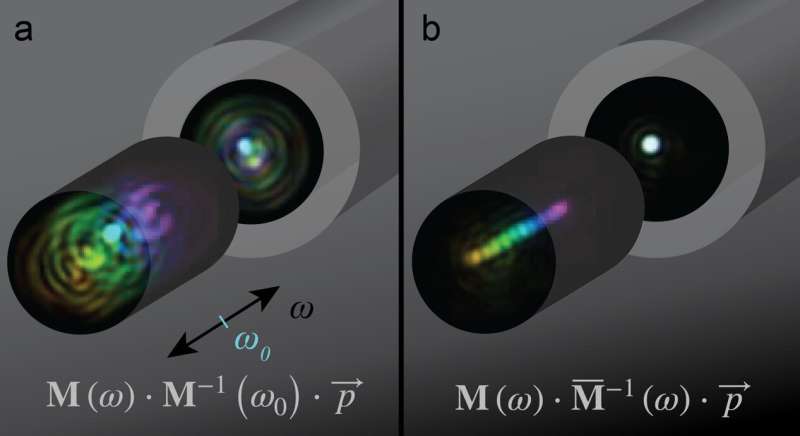Efficient calibration of wavelength-dependent transmission through optical multimode fiber

Researchers at the Wellman Center for Photomedicine have demonstrated that wavelength-dependent changes in the spatial distribution of light transmitted through a multimode optical fiber are not random but highly predictable.
They developed a dispersion model and computational methods for efficient measurement of the transmission of light through the fiber across a spectrum of wavelengths. Controlling the spatial transmission of light with different wavelengths through multimode fiber holds significant potential for applications in bioimaging and telecommunication.
Multimode fiber (MMF) consists of a light-guiding core embedded in a cladding with a diameter of typically only 125 µm, about the thickness of a human hair. Unlike single mode fiber, which has a core that is small enough to guide only a single spatial mode, MMF has hundreds to thousands of spatial modes that travel with distinct velocities and frequently couple among each other.
As a result, MMF efficiently transmits light, but without maintaining its spatial pattern. An input signal couples to a combination of modes that mix and experience distinct phase delays, creating a seemingly random output. Yet, the input and output electromagnetic fields are related in a linear fashion and the coupling coefficients between all involved input and output modes define the fiber’s coherent transmission matrix. In this view, MMF can be treated as an uncommon optical element.
Once the transmission matrix is known, typically through calibration, its effect can be compensated computationally or by means of a spatial light modulator. Progress with controlling light transmission through such complex media holds significant potential for future applications, including imaging through MMF for its use a miniature endoscope in biomedicine, and spatial multiplexing in telecommunication.
One of the prevailing challenges with controlling light transmission through MMF is the wavelength-dependence of the fiber’s transmission matrix. A minute change in wavelength elicits, in general, a seemingly independent distribution of the transmitted field. Controlled transmission at multiple wavelengths has required tedious calibration of transmission matrices at each wavelength.
In a new paper published in Light: Science & Applications, researchers at the Wellman Center for Photomedicine in Boston now demonstrate that, far from random, the wavelength-dependence of the multimode fiber transmission matrix is highly deterministic. They developed a parametric dispersion model and computational methods for efficient calibration of a fiber’s multispectral transmission matrix, obviating the need for dense spectral measurements.
It has long been recognized that it is possible to find a specific set of input patterns and corresponding output patterns that are relatively insensitive to a change in wavelength. A pulse of light launched into a single of these ‘principal modes’ is transmitted through the fiber without temporal scattering and arrives with a mode-characteristic delay.
“In order to achieve full spatial and spectral control, we need to be able to generate a suitable superposition of all principal modes by accounting for the phase offsets between the various modes and how these phases change with wavelength,” explains Szu-Yu Lee, lead author of the study and recent Ph.D. graduate from the Health Sciences and Technology program between MIT and Harvard.
And while the principal modes offer the smallest possible wavelength-dependence, they eventually do change in response to a sufficient wavelength variation.
Szu-Yu’s co-authors are Vicente Parot, formerly a postdoctoral researcher at the Wellman Center for Photomedicine and now Assistant Professor at the Pontificia Universidad Católica de Chile, Brett E. Bouma, Professor at the Wellman Center for Photomedicine, and Martin Villiger, Assistant Professor at the Wellman Center for Photomedicine.
The team recognized that the required control of the wavelength-dependent modal phase delays could be efficiently described with the algebraic concept of an exponential map. Developing the dispersion into various orders of wavelength-dependence furthermore enabled to account for more general wavelength-dependence.
This formulation drew inspiration from the way dispersion is modeled in lower dimensional systems, including free-space propagation through glass, or polarization mode dispersion in single mode fibers. Combined with suitable computational tools, Szu-Yu and his colleagues demonstrate in the study how the model can be fitted to experimental transmission matrices measured at only a few discrete wavelengths. Crucially, the parameterization enables inter- and extrapolation over a continuous range of wavelengths.
“The ability to efficiently calibrate the fiber’s multispectral transmission matrix may be decisive for my team’s efforts of imaging through flexible MMF. This future goal will require overcoming another prevailing challenge of controlling light transmission through MMF: The challenge of fiber deformation and the way it changes the transmission matrix,” explains senior author Martin Villiger.
More information:
Szu-Yu Lee et al, Efficient dispersion modeling in optical multimode fiber, Light: Science & Applications (2023). DOI: 10.1038/s41377-022-01061-7
Citation:
Efficient calibration of wavelength-dependent transmission through optical multimode fiber (2023, February 2)
retrieved 3 February 2023
from https://phys.org/news/2023-02-efficient-calibration-wavelength-dependent-transmission-optical.html
This document is subject to copyright. Apart from any fair dealing for the purpose of private study or research, no
part may be reproduced without the written permission. The content is provided for information purposes only.
For all the latest Science News Click Here
For the latest news and updates, follow us on Google News.

